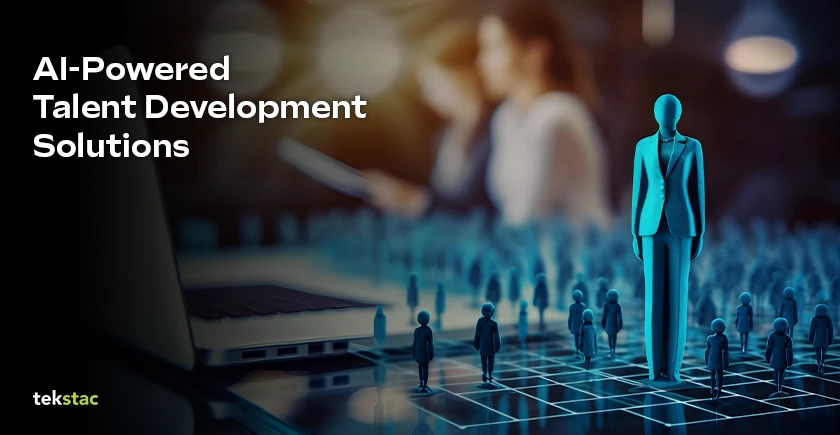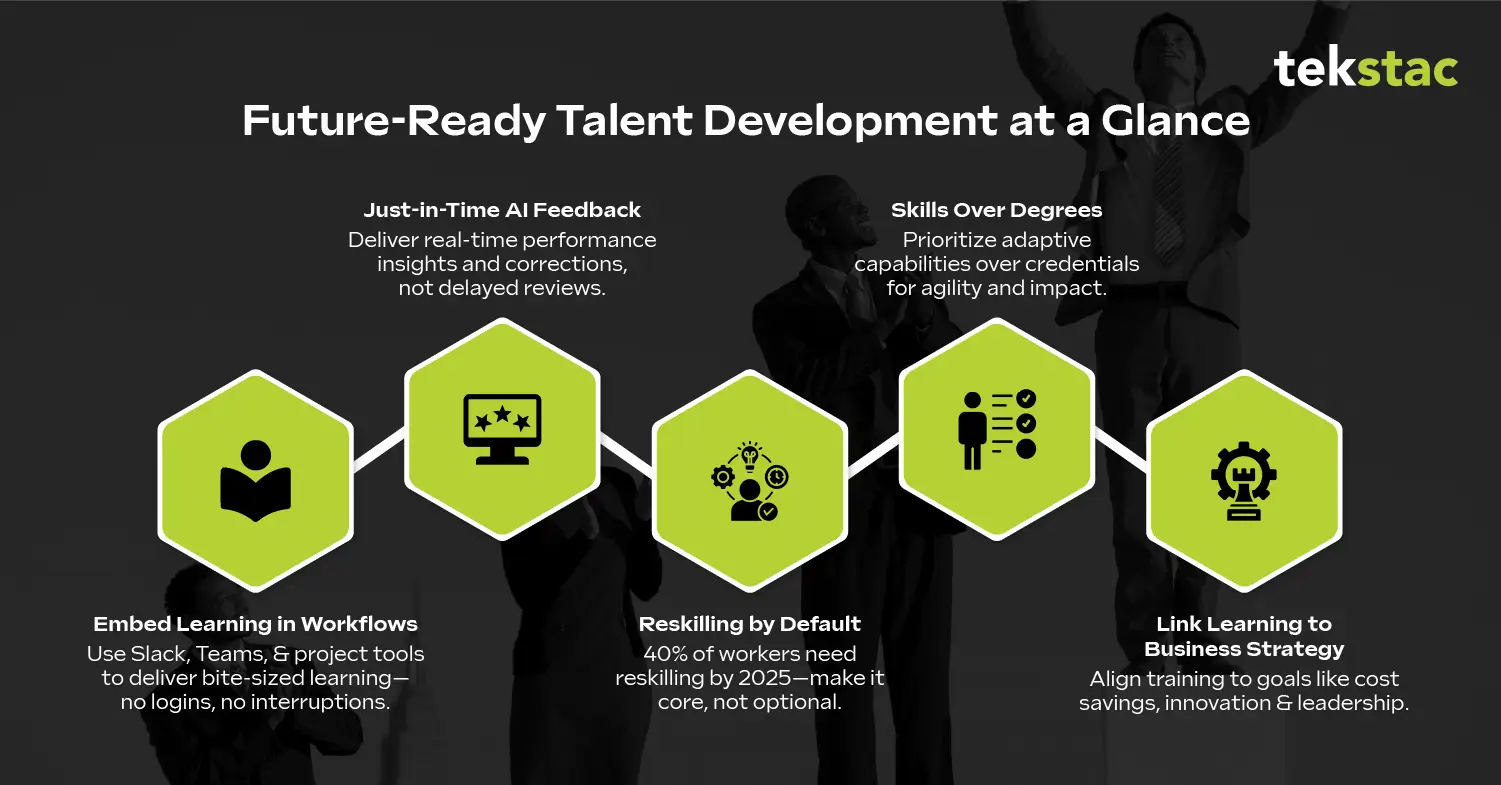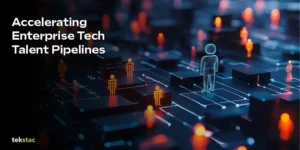How to Integrate AI and Automation in Talent Development Programs

The world of work isn’t just changing; it’s evolving faster than most companies can keep up. What used to work ten years ago, scheduled training sessions, fixed job descriptions, manual performance reviews, is now dangerously outdated.
In this environment, a business is only as strong as the adaptability of its people.
This is where Talent Development Programs come into the picture. These aren’t just employee workshops or onboarding checklists anymore. They are enterprise engines.
Engines that build skill, enhance judgement, and turn employees into contributors capable of facing the unknown with confidence.
According to a 2025 McKinsey report, 60% of executives now say their company’s competitive edge depends on how quickly they can reskill their people.
That’s not HR fluff.
That’s a strategic priority for business growth.
And yet, most organizations are still treating talent development like a cost center, not the profit multiplier it actually is.
The real problem is that training is still reactive. It’s not aligned to the job. It’s not intelligent. And in many cases, it’s not even reaching the right people at the right time.
That’s why businesses lose talent, productivity, and in the long run, relevance.
What Smart Talent Development Unlocks
There’s a better way. One that treats talent like a living system, not a static resource. The new standard for Talent Development Programs is adaptability.
Not just what employees know, but how quickly they can learn something new when the rules change.
This is where AI in learning and development becomes mission-critical. AI/ML based HRTech tools now enable companies to tailor learning paths for each individual, not just based on their role, but on performance patterns, their career aspirations, business requirements, learning style, and growth trajectory.
Take a look at what this unlocks
- Personalized learning delivered at the moment of need
- Real-time skill gaps analysis
- Auto-curated content libraries based on job performance
- Virtual mentors that provide 24/7 feedback and coaching
In a recent LinkedIn Workplace Learning report, companies that invested in AI-enabled talent development platforms reported a 23% increase in internal mobility and a 30% reduction in turnover.
That’s how powerful smart development can be.
And don’t ignore Upskilling through automation. When machines handle repetitive tasks, human workers must step into higher-order thinking roles, negotiation, decision-making, leadership. But they can only do that if they have the necessary skills.
When Companies Do It Right
Let’s break this down through a practical lens.
Unilever, one of the world’s top consumer brands, completely reshaped its approach to talent development by dismantling traditional roles and replacing them with task-based assessments.
Instead of promoting based on time served, employees were assessed based on project complexity, agility, and learning speed.
With AI embedded in its learning system, Unilever enabled every employee to build their own career map, automatically updated based on skill growth and business needs.
This shift didn’t just improve retention, it unlocked hidden talent across the entire organization.
Or consider Genpact, a global services company. When GenAI exploded onto the scene, they immediately created AI-driven employee development tracks focused on prompt engineering and LLM literacy.
Over 75,000 employees completed their AI foundation module in under 6 months, leading to a 3x increase in total learning hours over the past four years.
These aren’t edge cases. They’re the new standard.
The Pillars of Future-Ready Talent Development Programs
Now here’s what every business needs to start doing immediately

1. Build Learning into the Flow of Work
People won’t engage in training if it interrupts their work. That’s why modern Talent Development Programs embed learning into tools already being used — Slack, Teams, project management software. Microlearning modules triggered by real work tasks.
No separate login.
No off-site seminar.
2. Use AI to Deliver Just-in-Time Feedback
Learning must happen when it matters most. With AI in learning and development, systems can now evaluate an employee’s real-time performance, detect errors or gaps, and offer corrective content instantly.
No need to wait for the next quarterly review.
3. Make Reskilling a Default, Not a Perk
A 2025 World Economic Forum study found that over 40% of all workers will need reskilling within the next three years.
That means Upskilling through automation isn’t a nice-to-have. It’s a survival plan. Companies must fund, incentivize, and promote reskilling pathways by default.
4. Shift Focus from Degrees to Skills
Credentials are no longer the main currency of value. The ability to adapt, learn, and apply new knowledge rapidly is what counts. AI systems can assess these traits better than any traditional resume scan.
A recent SAP SuccessFactors case study showed that companies adopting skill-first development models saw a 26% increase in project delivery speed and a 15% improvement in leadership pipeline efficiency.
5. Map Development to Business Strategy
This is where too many get it wrong. Learning is treated as an HR metric, not a revenue enabler. True AI-driven employee development maps every learning track to a clear business objective — cost reduction, faster innovation, customer satisfaction, leadership capacity. Training must be an investment that pays back.
The Strategic Advantage Hidden in Plain Sight
Every company is sitting on a goldmine. Their people. But talent without development is just potential, not performance. The companies that win in this next decade won’t be the ones with the most capital, but the ones with the most adaptable workforce.
Talent Development Programs are no longer optional. They are the core infrastructure. As critical as cloud servers or cybersecurity. And when powered by AI, they don’t just train workers. They evolve them.
The time to act is now. The longer the delay, the wider the skills gap becomes.
And here’s the truth. Implementing this doesn’t have to be hard. Not with the right partner. There are platforms today that can deploy these capabilities out of the box — from smart learning paths to performance-linked coaching to skill analytics that make HR feel like strategy.
Let Intelligence Lead the Way Forward
It’s a different game now.
Static roles have been replaced by skill clusters. One-size-fits-all training is obsolete.
And AI isn’t just automating tasks — it’s building talent.
There’s no turning back. The choice for organizations is simple.
Keep relying on outdated training systems, lose people, fall behind.
Or, switch to intelligent, data-driven, personalized development and build a workforce ready for anything.
Unlock the Future of Talent Development
If there’s one place to start, it’s with a smart platform that aligns learning, performance, and business goals.
One that offers everything from skill taxonomies to AI-powered coaching, from role-based content curation to real-time feedback — all personalized, scalable, and integrated
Try Tekstac today and experience what intelligent talent growth can really look like
👉Get Started Now





